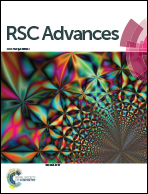Insights into the climate-driven evolution of gas hydrate-bearing permafrost sediments: implications for prediction of environmental impacts and security of energy in cold regions†
Abstract
The present study investigates the evolution of gas hydrate-bearing permafrost sediments against the environmental temperature change. The elastic wave velocities and effective thermal conductivity (ETC) of simulated gas hydrate-bearing sediment samples were measured at a typical range of temperature in permafrost and wide range of hydrate saturation. The experimental results reveal the influence of several complex and interdependent pore-scale factors on the elastic wave velocities and ETC. It was observed that the geophysical and geothermal properties of the system are essentially governed by the thermal state, saturation and more significantly, pore-scale distribution of the co-existing phases. In particular, unfrozen water content substantially controls the heat transfer at sub-zero temperatures close to the freezing point. A conceptual pore-scale model was also proposed to describe the pore-scale distribution of each phase in a typical gas hydrate-bearing permafrost sediment. This study underpins necessity of distinguishing ice from gas hydrates in frozen sediments, and its outcome is essential to be considered not only for development of large-scale permafrost monitoring systems, bus also accurate quantification of natural gas hydrate as a potential sustainable energy resource in cold regions.



 Please wait while we load your content...
Please wait while we load your content...